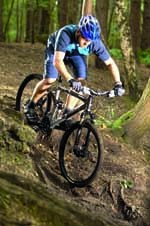 FRAME
FRAME
Unlike the traditional looking Cube, there is barely a round tube anywhere on the frame of the BeOne. From the very front, the bobbin-shaped head tube has not only been relieved of its structural non-essentials, but also decoratively machined. The top tube morphs from barely triangular to distressed diamond. Cables are routed in the concave lower planes. It’s difficult to know if such shaping has any profound effect but in this instance it makes for very neat routing.
An integrated gusseted down tube becomes a wide rectangle that mates well to the box-section four-bar rear end. Machined rocker plates link the rear to the shock and despite a small flame detail, they are not the nicest-looking examples of their kind.
SUSPENSION
Like the Cube, the Nirvana frame has a Horst link pivot, and on the BeOne it is similar in scale. Some other brands try to reduce the size, and therefore the weight, but this is always at the cost of stiffness. With an MC 3.1 shock and Recon 351 fork, all sprung elements come from the RockShox stable. Our shock was plagued by rebound problems, topping out even when set treacle slow. We ran our adjustable floodgate at minimum at all times, to make the most of the active rear suspension.
Up front the fork was more reliable. With the same bar-mounted Pop-Loc lever and adjustable rebound and compression damping we could tune the Recon 351s almost as much as the Reba SL, but without the dual air, we were left with the standard spring curve, rather than the tuneable dual air version. Only the steel steerer tube — adding half a pound — makes any real difference on the trail.
WHEELS
Maxxis Ignitors are an almost exact copy of Continental’s Explorer. Despite this, they actually outperform the Contis in terms of absolute grip when pushed hard. Rather than being individual blocks, the tread design is linked with buttressing, stiffening the tread. When at the edge of traction, this makes them less prone to squirming. A chamfered front edge also reduces rolling resistance on what is already a fast tyre.
Mavic’s X317 eyeletted rims are best on test but the hubs sound graunchy from the box, and spares will not be as readily available should a freehub or bearing problem manifest itself.
COMPONENTS
Full-width Ritchey Comp oversize bars and matching finishing kit, Avid Juicy brakes, Lock-on grips, Shimano shifting parts and a two-piece Truvativ chainset tick all the component boxes you need. There’s no doubting the spec level on this rig.
PERFORMANCE
On paper, the Nirvana 2.0 is a top-notch machine. Hydroformed frameset, genuine four-bar rear end, Avid Juicy brakes, Shimano drive and all the bells and whistles. But geometry is the make-or-break element for any off-road machine and sadly, the spec and shape don’t tally.
From the numbers on the angle finder you can see that the wheelbase is an inch shorter than the Cube, and with longer chainstays, the front end of the bike ends up very short indeed. Combine this with a super-steep 71deg head angle and you have a massive front-end weight bias. With the saddle at full height it feels as if you’re sat on top of the bars, with almost no weight over the rear wheel. Thanks to the long stem it’s not cramped, making climbing OK, but as soon as you hit a corner the front wheel wants to tuck under the bike and the back ends tries to come around. Downhills are just plain frightening. The real shame is the suspension is laterally rigid, unaffected by braking, and active (even with an iffy shock).
VERDICT
As the name suggests, the Nirvana 2.0 has everything required to take you to a better place. Alas simply by attaching the hydroformed tubes together in the wrong places, BeOne has ruined the dream.
If the frame was lighter we may suggest a possible use as a race steed, but it’s not a particularly svelte frameset. No matter how good the suspension design, or the spec, at the end of the day, if it is the wrong shape it will not be any fun.
MBR RATING: 4/10



